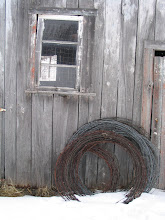 |
| Sea Buckthorn Berries |
Previous owners had planted these Sea buckthorn shrubs in the hedgerow, so we can't take credit for their avant-gardist planting philosophy. These shrubs are commonly used to prevent soil erosion and typically do well in sandy soils, but I'm here to tell you they do very well in our clay soil also.
These shrubs are dioecious, meaning there are male and female shrubs. The male shrubs have copper-coloured flowers, and the female plants produce masses of tart, orange berries that have 15 times more vitamin C than oranges. The berries are also full of essential fatty acids and can be processed into oil and juice. My mother made a syrup from the sea buckthorns last year, and she swears it helps against coughs and flu-like symptoms.
 |
| Sea Buckthorn flowers on a male plant |
Birds enjoy the sea buckthorn shrubs, and many of them hold a variety of nests. Predators such as raccoons stay away from the sea buckthorn, because, as the name implies, they are full of thorns as evidenced in the photos above.
It is these thorns that make picking the berries in late fall prohibitive. It takes lots of patience to pick a few pounds, and commercial growers actually cut the entire branch off and freeze them, so they can shake the seeds of the branches with ease. I'm not too convinced of the long-term viability of that concept, since you're always pruning back old growth. I suppose time will tell. At any rate, we're not interested in any commercial benefits, just happy to give away the odd plant or four to people who'd like to create a hedge, wind-break or prevent soil erosion along their shoreline. Our shrubs create many suckers which are easily dug up and transplanted. Every plant we have given away has flourished.
If you're interested in more information, some of the best on-line info I found was on the Ontario Ministry of Agriculture's website.
In the meantime, I've been religiously using sea buckthorn body oil from Weleda, and can't say enough good things about it. A little bit goes a long way. And if it can prevent harm from those cosmic rays, all the better.


2 comments:
I've been wanting to get a couple of those plants for a few years now. I've never actually tasted the fruit off of them though and I had no idea you could use them as a hedgerow.
Think of the tartest thing you've ever eaten, then multiply it. It could take a layer of teeth enamel off, it's that sour. I have no clue how my mother choked down her syrup last winter LOL. More power to her!
The shrub itself makes a fabulous hedgerow. All those lovely thorns, I guess it all depends on what you're trying to keep out! I don't trim ours back because they don't really need it, but for a more dense hedge, it can be groomed a bit. I bet they'd do well in your climate, which is much more temperate than ours.
Post a Comment